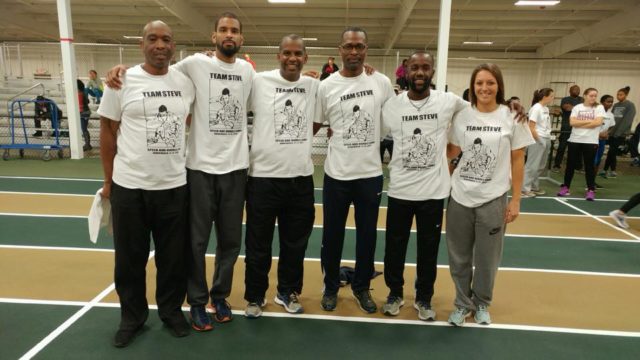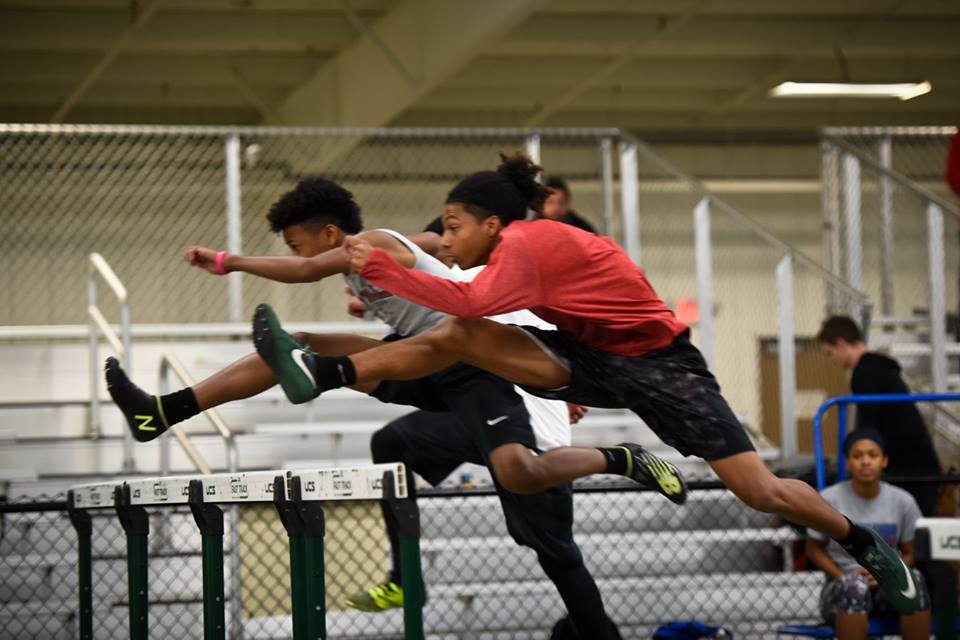A Successful Hurdle Camp
by Steve McGill
Last month, on November 11-12, 2017, the inaugural Team Steve Speed & Hurdle Camp took place at the renowned JDL Fast Track indoor facility in Winston Salem, NC. A total of 47 campers attended, almost all of whom were 10-17 years old, but we also had one master’s athlete who participated as well and learned a lot. While I have helped out at several speed/hurdle camps over the years, this was my first time conducting one myself, and I really enjoyed the experience. Organizing and conducting a camp of this size takes a whole lot of work and preparation, which is why I had been balking at the idea of doing so for so long.
[am4show not_have=’g5;’]
[/am4show][am4guest]
[/am4guest][am4show have=’g5;’]
But sometimes you get to thinking about your life and what you can do to expand upon what you’re already doing. I found myself doing that a lot over the past few years, as I kept hearing people kept hearing people ask me if I do camps and then expressing surprise when I told them no. After I moved from the Raleigh, NC area a few years ago to the Charlotte side of the state, I found myself disconnected from the legacy I had built and actually a bit happy to be free of all the pressures and responsibilities that come with being relied upon to guide athletes to success. But, you know, if you have a gift, you have to use it. So, once I started to do some private coaching in this area and then had some athlete do very well last year, it seemed like the time was right to spread the style of hurdling that I teach to a wider audience.
Plus, I remembered how jazz trumpeter and musical visionary Miles Davis had once said, toward the end of his life, that he didn’t want to be known as a “legend,” even though that term was used as a compliment. “Legends are dead,” he said, “but I’m still doing what I do.” Similarly, I had grown tired of being the guy who had coached Keni Harrison when she was in high school. Or Johnny Dutch or Wayne Davis. I’m current, bruh. I’m not living off what I did ten years ago. I’m right here right now. And running my own camp, I came to understand, would be a way to make that point clear.
The primary goal, as I explained to my staff of coaches, was to conduct a teaching camp. Our mission was to teach efficient sprinting mechanics, efficient hurdling mechanics, and efficient block start mechanics. As I told the campers on the morning of the first day, “We want you to leave here as tired mentally as you are physically.”
The coaching staff consisted of myself, Hector Cotto, Jenna Pepe, Kevin Howell, Booker Nunley and DJ Hicks. Let me talk about each of them briefly. Hector is probably best well-known these days as the coach who runs the sprinthurdles.com website. He’s 32 now and has all but retired from competing (he’s always talking about making a comeback), but he was an outstanding 110 hurdler back in the day. A graduate of East Carolina University, he holds that school’s school record in the 110’s. Also, he competed in the 2008 and 2012 Olympics for Puerto Rico, as well as the 2009 World Championships. His personal best in the 110’s is 13.46.
Jenna, who ran for me as a prep seven years ago, now coaches sprints and jumps at Meredith College (DIII) in Raleigh, and she is also the strength coach for all sports at the school. Jenna was our sprint specialist at the camp.
Coach Kevin Howell, who just recently accepted a position as sprints coach at Fayetteville State University shortly after the camp was over, has coached sprinters at the youth level and high school level for well over a decade. He and I worked together often on weekends and summers when I was living in Raleigh, and I coached his daughter, Jackie Howell, who is currently a senior at the University of Kentucky.
Booker and I go wayyyyyy back, as I coached both of his older sons – Booker IV and Malcolm (both of whom competed at a high level collegiately) – and also helped build the foundation for his youngest son, Alex, who won the national championship in the 13-14 year old age group at the Junior Olympics this past summer.
DJ serves as the sprint coach at Houston Baptist University, and when he heard about the camp, he eagerly contacted me offering to help out as a volunteer.

The Team Steve coaching staff: From left to right, Kevin Howell, Hector Cotto, Steve McGill, Booker Nunley, D.J. Hicks, Jenna Pepe
One thing that all the coaches had in common was that they were all excellent teachers. I have found that the one thing that separates the pretty good coaches from the really good coaches is the ability to teach – the ability to adapt their methods to the needs of the athletes, and the ability to explain things on the level that the athlete can understand. With the staff that I had, I knew that they were not only knowledgeable, but that they would be able to impart that knowledge in a manner that would enable the campers to take their lessons home with him. As I told the campers, the last thing I wanted was for them to learn a lot of stuff and then forget it all when they got back home. With that thought in mind, parents were welcome to stay and watch, to ask questions as time allowed, and to record on their phones.
So basically, for the hurdlers (about 85-90% of the campers were hurdlers), my staff and I put them through the gamut of drills and workouts that I have my hurdlers do when I coach privately. As I told the campers the first morning, “We’re gonna squeeze two months worth of learning into two days.” On day one, we started with basic sprint-mechanics drills like A skips, B skips, and high knees, placing an emphasis on doing them properly, stopping and giving instruction along the way. My point of emphasis was that all of the drills, even when there are no hurdles in the way, are hurdle drills. The skip drills and high knee drills are teaching very important mechanics that are essential to have in place if the hurdle motion is to be executed efficiently later.
After the sprint drills, we taught all the hurdlers the wall drill for the trail leg as we teach it, which includes an emphasis on pushing off the back foot and driving the knee and heel up together, emphasizing keeping the knee facing forward, even as the groin opens. The emphasis on pushing off the ball of the back foot is unique to our version of the drill; the emphasis on raising the knee as opposed to emphasizing opening the groin is also unique to our style. The logic for the first part is that the push off the back leg is what creates speed through the hurdle; the logic for the second part is that the less distance the trail leg has to travel, the easier it is to get it to the front.
After the wall drill, the younger hurdlers went to one part of the track to work on basic side walk-over drills for lead leg and trail leg, followed by cycle drills over low hurdles. The purpose of these drills was to teach the athletes the positioning of all four limbs as well as of the torso and head when clearing hurdles. Meanwhile, the older hurdlers were taught the marching pop-over drill, and we gradually added more difficulty level to the drill as we went on. The purpose of this drill is to teach the athlete to rely on the back leg for speed and power through the hurdle, and to keep the legs cycling, as opposed to allowing the lead leg to kick out and then snap down.
For a lot of hurdlers, the marching pop-overs is a very challenging drill that can cause a lot of frustration. This is especially true for hurdlers who have gotten into the habit of relying on their leg lead to create all their speed for them. As I told the campers, “We wanna be hip flexor hurdlers, not hamstring hurdlers.” What that means is, we want the hip flexor of the lead doing doing the work, not the hamstring. If the hip flexor is doing the work, that means the knee is attacking the bar, not the foot. As a result, the lead leg (and consequently the trail leg) can cycle over the hurdle instead of adding the extra effort of the snapdown. But once an athlete who is new to the drill finally “gets it,” he or she is pleasantly surprised to discover how easy it is to hurdle that way. As I told them, in this drill, “we don’t hurdle; we step over the hurdle.” Then, when it’s time to go full speed, “we don’t hurdle; we sprint over the hurdle.” In other words, we just take what we’re already doing and continue it over the hurdle. The push off the back leg allows us to do so.
From there, we moved on to the cycle drill and then, after warming up again, we dedicated the afternoon to the quick-step drill. So, we sped things up a bit from the morning session, adding a layer of challenge, but the principles we were teaching remained the same.
The next day we transitioned into block starts and making the mental transition from emphasizing hurdling technique to being fast, aggressive, and powerful. By the afternoon, we were doing competitive starts against athletes of similar ability, starting with one hurdle and working our way up to four. We also kept the hurdles one click below race height for the simple fact that it was November. No need to force the issue and potentially encourage any bad habits.
By the end of the two days, athletes and coaches were equally exhausted, but it was that good exhaustion after you’ve done something that was very challenging and very productive, and therefore quite fulfilling. We’re hoping to do another one in the spring, so stay tuned!
[/am4show]


